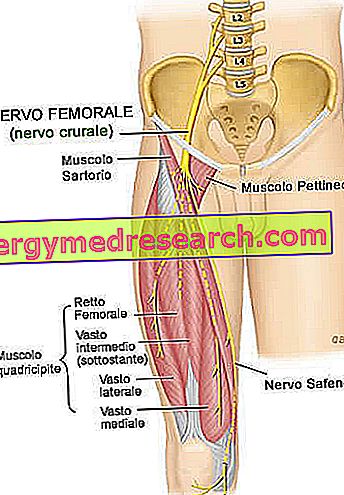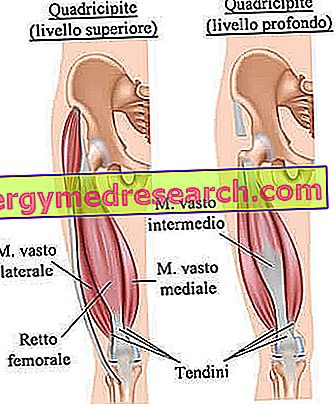Generality
The crural nerve is an important peripheral nerve of the lower limbs, which derives from the so-called lumbar plexus and which, with its branches, innervates the groin, the thigh, the leg and part of the foot.

Image modified from the website: Cursoenarm.net
Having both a motor function and a sensory function, the crural nerve contains the nerve fibers of the spinal roots L2, L3 and L4. Along the way, the nerve in question gives rise to several branches (or branches): the so-called abdominal branches of the crural nerve, the so-called branches of the anterior division of the crural nerve and, finally, the so-called branches of the posterior division of the crural nerve.
At the motor level, the crural nerve controls the hip flexor muscles and the knee extensor muscles. On a sensitive level, however, it controls the sensitivity of the anteromedial portion of the thigh, the medial side of the leg and the medial side of the foot.
The crural nerve can be the victim of damage or damage.
Short review of what a nerve is
To fully understand what a nerve is, it is necessary to start from the concept of neuron .
Neurons represent the functional units of the nervous system . Their task is to generate, exchange and transmit all those (nervous) signals that allow muscle movement, sensory perceptions, reflex responses and so on.
Typically, one neuron consists of three parts:
- The so-called body, where the cell nucleus resides.
- Dendrites, which are equivalent to receiving antennae for nerve signals from other neurons or receptors located in the periphery.
- Axons, which are cellular extensions having the function of spreading the nervous signal. The axon covered with myelin (myelin sheath) is also called nerve fiber.
A bundle of axons forms a nerve .
Nerves can carry information in three ways:
- From the central nervous system (CNS) to the periphery . The nerves with this property are called efferent. The efferent nerves control the movement of the muscles, so I am in charge of the motor sphere.
- From the periphery to the CNS . Nerves with this capacity are called afferent. Nervous patients report to the CNS what they detected in the periphery, therefore they cover a sensitive (or sensory) function.
- From the SNC to the periphery and vice versa . Nerves with this double capacity are called mixed. Mixed nerves have a dual function: motor and sensory.
What is the crural nerve?
The crural nerve, or femoral nerve, is an important nerve of the peripheral nervous system (PNS), which runs along the lower limbs and performs both motor functions and sensory functions.
The crural nerve is the largest branch of the so-called lumbar plexus . The lumbar plexus is an important reticular formation of various spinal nerves (which are also their nerves in the peripheral nervous system), which have the task of innervating part of the abdomen and the entire lower limb.
As can be easily understood, each lower limb has its own crural nerve, so the human body includes a right crural nerve and a left crural nerve.
In addition to the crural nerve, from the lumbar plexus originate: the ileoipogastric nerve, the ileoinguinal nerve, the genitofemoral nerve, the lateral cutaneous nerve of the thigh and the obturator nerve .
Anatomy
The crural nerve includes the nerve fibers of the spinal roots L2, L3 and L4 (NB: to better understand what spinal roots are, readers are advised to read the article here).
ORIGIN AND COURSE OF THE CRURAL NERVE
The crural nerve arises from the lumbar plexus at the level of the abdomen, approximately at the level of the fifth lumbar vertebra. From here, it passes through the large psoas muscle and moves towards the lower limb, occupying an anterior position with respect to the iliac bone ; the iliac bone is, together with the sacrum and coccyx, one of the three bony elements that form the so-called pelvic bones .
At the level of the groin - therefore not yet in the thigh - it flows behind the so-called inguinal ligament and immediately, after passing the latter, it separates into the so-called anterior division and posterior division of the crural nerve.
The anterior division and the posterior division of the crural nerve are two sets of nerve branches, which have various functions.
The crural nerve forms, along with the so-called femoral sheath, the great saphenous vein and the sartorius muscles, a long adductor, ileopsoas and pectineus, an anatomical region known as the femoral triangle (or Scarpa's triangle ). The femoral triangle marks the anatomical point, after which the crural nerve separates into the branches of the anterior division and the posterior division.
ABDOMINAL BRANCHE OF THE CRURAL NERVE
At the abdominal level, the crural nerve gives rise to some very small branches, which - as will be seen in the chapter on functions - serve to innervate the iliac muscle .
BRANCHE OF THE CRURAL NERVE: FRONT DIVISION
The anterior division of the crural nerve includes branches with mixed functions, thus covering both a motor function and a sensory function simultaneously.
The branches of the anterior division of the crural nerve are: the lateral (or intermediate ) musculocutaneous (or nerve) branch and the medial musculocutaneous (or nerve) branch .
BRANCHE OF THE CRURAL NERVE: REAR DIVISION
The anterior division of the crural nerve includes branches with motor function and branches with a sensory function.
The branches with motor function are the 4 so-called nerves of the quadriceps femoris ; the femoral quadriceps is the muscle group that resides in the front of the thigh.
The branches with sensory function, on the other hand, are the so-called saphenous nerve and the so-called articular branches of the knee .
Function
As anticipated, the crural nerve, through the branches of the anterior division and the posterior division, fulfills both motor functions and sensory functions.
MOTOR FUNCTIONS
The crural nerve innervates the muscles of the anterior thigh compartment. These muscles are the so-called hip flexors and so-called knee extenders.
- Hip flexors . The hip flexor muscles, innervated by the crural nerve, are:
- The pectineus muscle . It is used for adduction and flexion of the thigh; moreover, it contributes to the medial rotation of the thigh.
Its innervation depends on the motor nerve fibers of the medial musculocutaneous branch (anterior division of the crural nerve).
- Iliac muscle . Together with the major psoas muscle and the minor psoas muscle, it contributes to the flexion of the thigh towards the hip joint; it also gives stability to the latter.
Its innervation depends on an abdominal branch of the crural nerve.
- The sartorius muscle . It is used for flexion, abduction and lateral rotation of the thigh, with respect to the hip. In addition, it contributes to knee flexion.
Its innervation depends on the motor nerve fibers of the lateral musculocutaneous branch (anterior division of the crural nerve).
- Knee extenders . The knee extensor muscles, innervated by the crural nerve, are those muscle elements that make up the so-called femoral quadriceps. The muscles of the quadriceps femoris are: the rectus femoris, the vastus lateralis, the vast intermediary and the medial vessel. The function of these muscles is to ensure the extension of the leg relative to the knee.
The innervation of the knee extensors belongs to the branches of the posterior division of the crural nerve.

SENSITIVE FUNCTIONS
The sensitive functions of the crural nerve belong to the sensitive fibers of the medial musculocutaneous branch, to the sensitive fibers of the lateral musculocutaneous branch, to the saphenous nerve and to the articular branches of the knee.
- Sensitive fibers of the medial musculocutaneous branch and sensitive fibers of the lateral musculocutaneous branch . Together, these two types of sensory fibers innervate the skin of the anteromedial region of the thigh, providing the so-called skin sensitivity of the aforementioned anatomical section.
- Saphenous nerve . Representing the terminal tract of the crural nerve, the saphenous nerve provides the cutaneous sensitivity of the medial side of the leg and the medial side of the foot.
- Articular branches of the knee . There are a total of 3 and they provide the transmission of the sensitive functions coming from the joint capsule and the synovial membrane of the knee.
| Summary of branches of the crural nerve and their functions | ||
| Branche | Function | innervation |
| Abdominal branches | Motor function | They provide for the innervation of the iliac muscle |
Branches of the front division
| The medial musculocutaneous branch and the lateral musculocutaneous branch are mixed nerves, ie they possess both motor nerve fibers and sensitive nerve fibers | The motor fibers of the medial musculocutaneous branch innervate the pectineus muscle The motor fibers of the lateral musculocutaneous branch innervate the sartorius muscle The sensitive fibers of the medial musculocutaneous branch and the sensitive fibers of the lateral musculocutaneous branch innervate the cutaneous region of the anteromedial portion of the thigh |
Branches of the rear division
| The 4 nerves of the quadriceps femoris have motor functions The saphenous nerve has sensitive functions The articular branches have sensitive functions | The 4 nerves of the quadriceps femoral innervate the rectus femoris muscle, the vastus lateralis muscle, the vastus intermediate muscle and the vastus medialis muscle The saphenous nerve provides the skin sensitivity of the medial side of the leg and foot The articular branches provide the transmission of the sensitive information coming from the joint capsule and from the synovial membrane of the knee |
diseases
The crural nerve can be the victim of damage or compression. Damage or compression of the crural nerve are injuries that can affect both motor function and sensory function.
The possible causes of crural nerve damage include traumas to the nerve structure in question; among the possible causes of compression of the crural nerve, on the other hand, there is the presence, near the nerve structure in question, of a tumor mass or a hematoma.
EFFECTS AT MOTOR LEVEL
At motor level, damage or compression of the crural nerve can result in atrophy of the quadriceps muscle and loss of extensive knee capacity and hip flexion capacity.
The motor effects depend on where the crural nerve damage or compression occurs.
EFFECTS AT SENSITIVE LEVEL
At sensory level, damage or compression of the crural nerve can result in loss of skin sensitivity in the anteromedial compartment of the thigh and / or loss of skin sensitivity in the medial side of the leg and foot.
As with motor effects, the sensory effects depend on where the crural nerve damage or compression is located.




